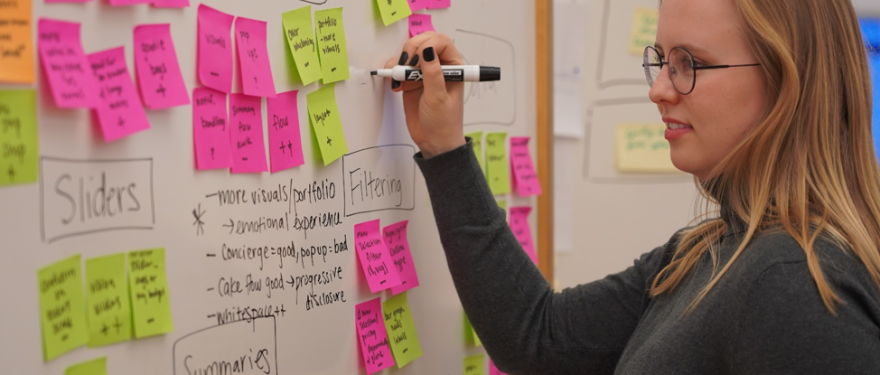On Monday January 13th, 28 students from the inaugural MS-MBA: Engineering Sciences cohort gathered in Batten Hall to begin “Launch Lab”, a two-week intensive course that forms part of the capstone for the new program. Over the following two weeks, the students negotiated a series of exercises and class content, geared to having them develop their ideas for a new venture, build rapid prototypes of their new products, test these prototypes with customers, and assess the viability of the resulting venture by developing a pitch deck and delivering it to potential investors.
Eleven student teams were required to run a “design sprint” – a structured and rigorous process for quickly identifying critical questions facing a venture, and rapidly developing multiple answers to these questions to test with stakeholders. A highlight of the week was a guest appearance by Jake Knapp of Google Ventures, who invented the Sprint process, and popularized it in the book of the same name. Jake ran the first two days, then handed over to faculty co-chairs Alan MacCormack and Russ Wilcox. The pressure was on the teams to make progress, rapidly building prototypes to a high level to generate insightful feedback on how well the solutions matched real customers’ needs.
A unique feature of the course is that it is designed for teams with ideas at different stages, allowing teams to bring ideas into the course from prior MS-MBA courses, or to start afresh. In common, all teams were committed to developing solutions with significant technical content.
Here, MS/MBA student, Amelia Elverson, shares her experience learning through the sprint method and talks about her 5 key takeaways from Launch Lab 1.
As a future product manager, I loved these sessions. I was born to draw designs on whiteboards and sticky notes, to interview customers, and design prototypes. Utilizing the process that Jake was teaching us, we were able to do all these things in a guided and efficient way that led each of our teams to make a lot of progress in only a week.
My team worked on a product designed to attack price transparency issues in the wedding industry. Through this process, we conducted customer interviews, devised many product iterations, developed two prototypes, and conducted both moderated and unmoderated user tests – all in one week. Below, I am sharing the top five things I learned during Launch Lab 1 – and what I’m carrying with me into my product management career.

1. Start with the customer.
Why do you design products? Theoretically, you don’t do it just for the sake of building something. The goal of any product team is to create something that not only solves a problem for the customer but solves it in a way that it becomes indispensable. The best way to accomplish that goal is by really understanding the customer and experiencing what they are feeling. For our product, we conducted user interviews so that we could learn about what the couples experienced during the wedding planning process. We wanted to get to the bottom of what they liked or disliked, what made them frustrated, and more.
2. End with the customer.
We applied the same principle at the end of the design sprint as well. We built two prototypes, and we put them in front of the customers to see how they interacted with the product and learn about how they received it. After these interviews, it was clear that the optimal product was a blend of the two solutions.
3. Find a problem first, then start solving it.
When conducting initial customer interviews, it’s very easy to jump to creating solutions. It’s easy to think, “Oh, this problem could be solved by X.” We had to consistently hold back from jumping to conclusions in order to fully understand the customer, competitive landscape, and where the pain points lie. Our gut reaction was to build something much larger than was possible or necessary, but it turned out that our scope could be much smaller, and it would still have a great impact.
4. Get really out there – within reason.
Throughout the design sprint, Jake taught us a tool called “time boxing.” Whenever we did brainstorms, we were encouraged to get really creative, within a very constrained time frame. We also practiced Jake’s principle of “separate then together” – we each brainstormed individually for a short, predetermined period of time, 5 minutes usually, and would draw or write ideas out on post-it notes. Then, we would get together and share them. We would group those ideas into primary categories, and then use those overarching principals to inform our actual designs. This process helped us be creative in a controlled way and led us to great solutions.

5. Remember, your team is everything.
For any new company, it really comes down to the people. We heard this again and again from Venture Capitalists – they are investing in the team, not the product. I was lucky to work with a great team: Matt Byrne and Jade Kessler. We all got along well, of course, but we were also great at being present and turning away distractions (i.e., phones and laptops) while we were working. We were supportive and made sure everyone felt heard, and we made decisions and moved on without protest or hard feelings. I feel so lucky to have met my teammates through the MS/MBA: Engineering Sciences program, and made not only strong professional connections but also lifelong friendships. I’m lucky to have this team continue into the Spring semester for Launch Lab 2!

